
WAFFEN-LOESCHE, Wasserschutzpolizei, We Buy Medals, We Buy Navy Daggers, Who Buys Nazi Memorabilia, WW2 German helmet, ww2 leather flying helmet,

WW2 items are highly valuable !
Financial Reward is Waiting In
Exchange For Historic WW2 Memorabilia.

This is the pioneering specialist
website tasked with acquiring and thus
preserving WW2 Memorabilia.
We buy historical items
of every description ,
from all countries around the
world We provide free valuations
and identification for any
number of pre 1946 Militaria
Fast, Accurate , Free Appraisals
If you’re simply curious how much
your WWII items are worth yet you are
not ready to sell We provide free appraisals.
No commitment on your part is
expected we are conscious of those
within the industry pressurise those
who contact them. Our believe
is simply this. If we provide the most
winning offers/valuations
we will get our fare share of business ..
Emails are responded to quickly and professionally.
Many emails will be responded to within one hour.
Please make sure when emailing,
that you take clear pictures of the WWII item.
A brief history of where it came from
would be nice, but usually not necessary.
Shipping and Payment Information
NEVER SEND GOODS WITHOUT
PRIOR PAYMENT EVEN TO CANADA !
Be smart, be safe on internet transactions.
Google my name / website
to see that I am legit with only positive
transactions. References upon Request.
Payment can be made in advance
though: PayPal (recommended),
Or Money Order, Cashiers Check
or Western Union for goods received .
We make the selling process of your
WW2 memorabilia fast and easy.
David Mattey of WW2 Buyer has turned his
lifelong love of Militaria into a career .
David Says he is comforted to know that he plays a
part in locating and preserving
historic items for generations to come.
Top Prices paid in advance
(Paypal)lmets, caps, visors, flags,
field gear, equipment, medals, insignia, uniforms, knives, guns,
paper work, trench art, photo albums, battle souvenirs, relics or
veteran’s bring backs. Every nations WW2 memorabilia is required
by the industry’s most conscientious buyer, including, but not limited
to: US, German, Japanese, Russian, and Italian militaria. Individual
pieces and large lots welcomed. Sell WWII German helmets here.
for your World War 2 Militaria, to Include heccccc The memory of service
provided by your family member is of great importance to us .
Details of the late owners will be rewarded by additional payments.
All WWII items happily accepted for a free appraisal
If you are simply curious as to what your World War Two item is worth,
WW2buyer.com are happy to take a look at images received and provide
you the correct market valuation . We appreciate all messages
received regardless of weather you are ready to sell or a simply curious..
Do not be taken in by advertisers who claim to be collectors or teaches
this type of website is very expensive to run and to maintain it’s position.
Think carefully before taking the first offer gain
several opinions then you will now who to deal with and who to forget.
Edit this page
To Obtain Offers Call +447860747027
Trade In German Badges
Of The Third Reich
Has Been Forced
Underground.
Why Sell To German Badges Wanted ?
All historical artifacts acquired by
German Badges Wanted.com are for
the consumption of mature collectors,
Museums, And educational facilities.
A New Generation
Of The Politically Correct
Find It Offensive For
Genuine Army,Navy ,
And Airforce Badges To
Be Offered For Sale .
German Badges Wanted.Com
Respect The Sensitivity Of
Exposing People To Swatikas
Against Their Will.
We Would Like Take
this Oppotunity To
Entirely Distance
Ourselves From
Those Who Support
The Evil Ideology Of
Facist Political Groups
Past And Present.
Our Customers Include
Museums,
Advanced Collectors,And
Ethical Investment Groups.
Artefacts From History
Should Be Preserved In .
An Un Edited Form.
German Badges Are
Extreamly Valuable.
By Selling Directly
To Dedicated.
Proffesionals
.david@germandaggerbuyers.com
i 1914-15 star,
1939-45 Star, abyssinian war medal,
Africa Star,
Christianswerk, Solingen M7/10 J. A. Henckels, Solingen M7/11 E. Knecht & Co., Solingen M7/12 Carl Robert Kaldenbach (duplicate) M7/13 Arthur Schüttelhofer & Co., Solingen M7/12 WMW – Waffenfabrik Max Weyersberg, Solingen M7/15 Carl & Robert Linder, Solingen M7/16 Justus Brenger & Co., Christianswerk, Solingen M7/10 J. A. Henckels, Solingen M7/11 E. Knecht & C
arctic medal,
Arctic star,
baltic medal,
Battle of Britain,
boultons medal, british empire medal,
canada medal, CAP BADGES,
china war medal, Conspicuous Gallantry Medal,
crimea medal, davisons medal,
defence of lucknow medal,
Distinguished Flying Cross, Distinguished Flying Medal,
Distinguished Service Cross, Distinguished Service Medal,
Distinguished Service Order, egypt 1801 medal,
Gallantry Medals, General Service Medal, George Medal,
indian mutiny medal, liverpool shipwreck and humane society medal,
Medal Valuation Service, Medals, Military Cross,
military general service medal, Military Medal,
naval general service medal, New Zealand Medal, order of st john medal,
red cross medal, Royal Life Saving Society Medal,
sea gallantry medal, South Africa Medal,
trafalgar medal, Victorian Campaign Medals, War Medal, waterloo medal,

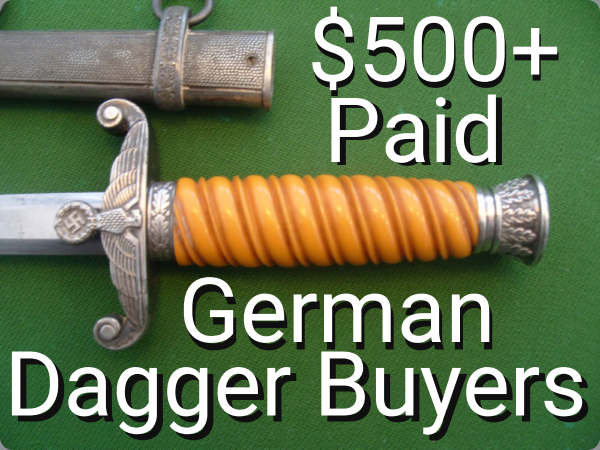
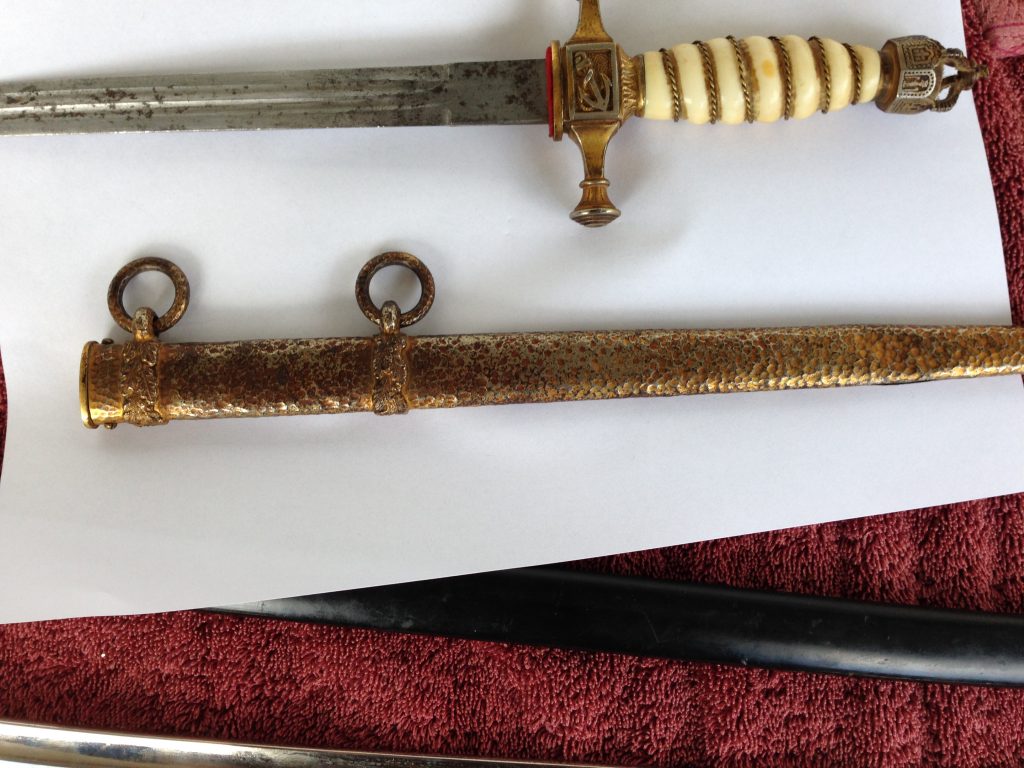
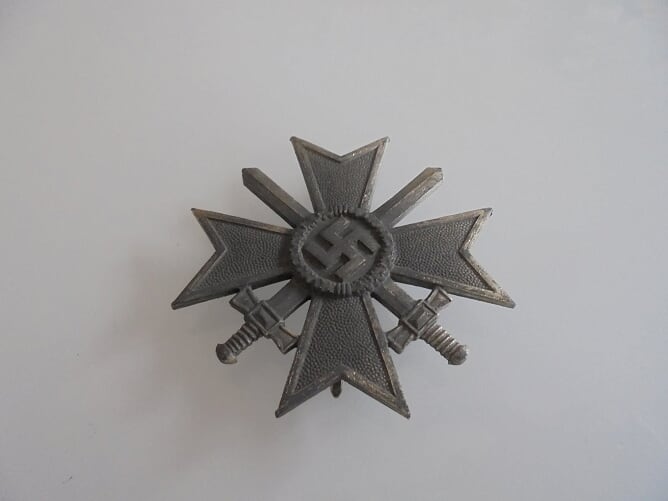

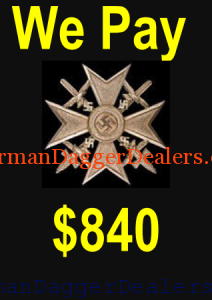
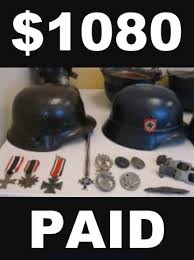
Free Up To The Moment
Offers/Valuations
Nazi Badge Prices?
From The
Longest Established
Militaria Buyers On Line.
Arundel Militaria Specialist
German Badges Wanted.com
Pay Your Researched
Prices In Full!
We Need Your Business!
We Cannot Afford To Fail You!
We are always
happy to help you with
We make sure that
War veterans,
their widows and families
get the
correct deal
they deserve when selling
to us at
German badges wanted.com.
An Englishman owns the largest
collection of Nazi artifacts
As the crimes of the Nazi regime retreat
further into the past, there seems to be
an increasing desperation in the race to get
hold of mementos of the darkest chapter
of the 20th century.
In the market for Nazi
memorabilia, two out of the three principal
ideologies of the era
— fascism and capitalism —
collide, with the mere financial
value of these objects used to
justify their acquisition, the spiralling
prices trapping collectors in a frantic
race for the rare !.
An Englishman
owns the largest collection
of Third Reich Militaria
When he was 5 years old, He received an
unusual birthday present from his parents:
a bullet-Damaged Waffen SS helmet,
A lightning bolt transfer on It’s side.
It was a special request.
The next year, at a car auction in Monte Carlo,
he asked his multimillionaire father for
a Mercedes: the G4 that Hitler rode into
the Sudetenland in 1938.
Father refused to buy it and his son
cried all the way home.
At 15, he spent birthday money from
his grandmother on three WWII Jeeps
recovered from the Shetlands,
which he restored himself and sold
for a tidy profit.
He invested the
proceeds in four more vehicles,
together with his very first tank.
The Englishman begged his father
to buy him Hitler’s Mercedies when
he was just six-years-old, and cried
when his father refused. He now owns it.
After leaving school at 16, he went
to work for an engineering firm, and
then for his father’s construction company.
He spent his spare time touring
wind-blasted battle sites in Europe
and North Africa, searching for tank parts
and recovering military vehicles that
he would ship home to restore.
The ruling passion of his life,
though, is what he calls the
— widely regarded as the world’s
largest accumulation of German military
vehicles and Nazi memorabilia.
The collection has largely been
kept in private,
under heavy guard, in a warren of
industrial buildings. There is no
official record of the value of His
collection, but some estimates place
it at over $160 million.
Since that initial SS helmet,
His life has been shaped by his
obsession for German military memorabilia.
He has traveled the world tracking down
items to add to his collection,
flying into remote airfields, following
up unlikely leads, throwing himself into
hair-raising adventures in the pursuit
of historic objects.
He readily admits that his urge to accumulate
has been monomaniacal,
Often elbowing out a regular social and family life.
The French theorist Jean Baudrillard once
noted that collecting mania is found
most often in “pre-pubescent boys and
males over the age of 40”; the things we hoard,
he wrote, tend to reveal deeper truths.
Despite the trade of Nazi antiquities being
banned or strictly regulated in many countries,
the market’s annual global turnover is
expected to be in excess of $47 million.
A signed copy of Mein Kampf goes for around
$31,000.
His Father came back with a wife, who he had
first seen from the turret of a tank as he pulled
into her village in Germany.
Father made hundreds of millions in the post-war
building boom, then spent the rest of his
life indulging his zeal for motor cars.
Our Englishman speaks of his late father as
“not just my dad, but also my best friend Despite
being one of seven children,he was the sole
beneficiary of his father’s will. He no longer
speaks to his siblings.
It is hard to say how much the echoes of
atrocity that resonate from Nazi artifacts
compel the enthusiasts who haggle for and
hawk them. The trade in Third Reich antiquities
is either banned or strictly regulated in Germany,
France, Austria, Israel and Hungary.
Still, the business flourishes, with burgeoning
online sales and increasing interest from
buyers in Russia, America and the Middle East;
The Englishmans biggest rival is a mysterious,
unnamed Russian buyer.
A Holocaust denier runs one of the
most-visited Nazi antiquities websites,
and is currently verifying charred bones
said to be those of Hitler and Eva Braun
Naturally, exact figures are hard to come by,
but the market’s annual global turnover is
estimated to be in excess of $47 million.
One of the most-visited websites is run
by Holocaust denier David Irving,
who in 2009 sold Hitler’s walking stick
(which had previously belonged to Friedrich
Nietzsche) for $5,750. Irving has offered strands
of Hitler’s hair for $200,000, and says he is
currently verifying the authenticity
of charred bones said to be those of
Hitler and Eva Braun.
There is also a roaring trade in the
automobiles of the Third Reich — in 2009,
one of Hitler’s Mercedes sold for almost
$7.8 million. A signed copy of Mein Kampf
will set you back $31,000, while in 2011 an
unnamed investor purchased Joseph Mengele’s
South American journals for $473,000.
As the crimes of the Nazi regime
retreat further into the past, there
seems to be an increasing desperation
in the race to get hold of mementos of the
darkest chapter of the 20th century.
In the market for Nazi memorabilia, two out
of the three principal ideologies of the era
— fascism and capitalism — collide,
with the mere financial value of these
objects used to justify their acquisition,
the spiralling prices trapping collectors
in a frantic race for the rare and the covetable.
In Walden, Henry David Thoreau observed
that “the things we own can own us too”;
this is the sense I — that he started off
building a collection, but that very quickly
the collection began building him.
‘I was in the area’
Inside one of the countless rooms where
Our gentleman keeps his artifacts.
He speaks of wanting people to see
his collection, “I’m only one man and
there’s just so much of it.
When I went to Leicestershire near the
end of last year to see the collection,
a visibly tired Our Man met me off the train.
“I want people to see this stuff,” he told me.
“There’s no better way to understand history.
But I’m only one man and there’s just so much of it.”
He had been trying to set his collection in order,
cataloging late into the night, and making
frequent trips to Cornwall, where, at
huge expense, he was restoring the only
remaining Kriegsmarine S-Boat in existence.
Wheatcroft had recently purchased two
more barns and a dozen shipping
containers to house his collection.
The complex of industrial buildings,
stretching across several flat Leicestershire acres,
seemed like a manifestation of his obsession — just as haphazard, as cluttered and as dark.
As we made our way into the first of his warehouses,
He stood back for a moment, as if shocked by
the scale of what he had accumulated.
Many of the tanks before us were little more
than rusting husks, ravaged by the years
they had spent abandoned in the deserts
of North Africa or on the Russian steppes.
They jostled each other in the warehouses,
spewing out to sit in glum convoys around
the complex’s courtyard.
“I want people to see this stuff.
There’s no better way to understand history.”
“Every object in the collection has a story,”
He told me as we made our way under
the turrets of tanks, stepping over
V2 rockets and U-boat torpedoes.
“The story of the war, then subsequent wars,
and finally the story of the recovery and
restoration. All that history is there in
the machine today.”
We stood beside the muscular bulk of a
Panzer IV tank, patched with rust and
freckled with bullet holes, its tracks
trailing barbed wire.
Wheatcroft scratched at the palimpsest
of paintwork to reveal layers of color
beneath: its current livery, the duck-egg
blue of the Christian Phalangists from
the Lebanese civil war, flaking away to the
green of the Czech army who used the
vehicles in the 1960s and 70s, and
finally the original German taupe.
The tank was abandoned in the
Sinai desert until The Enthusiast arrived
on one of his regular shopping trips
to the region and shipped it
home to Leicestershire.
Wheatcroft owns a fleet of 88 tanks
— more than the Danish and Belgian
armies combined. The majority of
the tanks are German, and Wheatcroft
recently acted as an adviser to David Ayer,
the director of “Fury” (in which Brad Pitt
played the commander of a German-based
US Sherman tank in the final days of the war)
. “They still got a lot of things wrong,”
he told me. “I was sitting in the cinema
with my daughter saying, ‘That wouldn’t
have happened’ and ‘That isn’t right.’
Good film, though.”
Modal Trigger
A Panzer (or Panzerkampfwagen) III,
used by the German forces during World War II.
Wheatcroft owns a Panzer IV tank,
as well as a fleet of 88 other tanks.
Around the tanks sat a number of
strange hybrid vehicles with caterpillar
tracks at the back, truck wheels
at the front.The enthusiast explained
to me that these were half-tracks,
deliberately designed by the Nazis
so as not to flout the terms of the
Treaty of Versailles, which stipulated
that the Germans could not build tanks.
He owns more of these than anyone
else in the world, as well as having
the largest collection of Kettenkrads,
which are half-motorbike, half-tank,
and were built to be dropped out of gliders.
A Kettenkrad, an army motorcycle that
the Germans built during World War II
after the terms in the Treaty of Versailles
stipulated the Germans could not build tanks.
He owns more of these half-motorbike,
half-tank vehicles, than anyone in the world.Photo: AP
“They just look very cool,”
he said with a grin.
Alongside the machines’ stories of
wartime escapades and the sometimes
dangerous lengths that He had gone
to in order to secure them were the
dazzling facts of their value. “The Panzer
IV cost me $25,000. I’ve been offered two
and a half million for it now. It’s the
same with the half-tracks.
They regularly go for over a million each.
Even the Kettenkrads, which I’ve picked
up for as little as $1,500, go for $235,000.”
I tried to work out the total value of the
machines around me, and gave up
somewhere north of $78 million.
He had made himself a fortune,
almost without realizing it.
“Everyone just assumes that I’ve inherited
a race track and I’m a spoilt rich kid who
wants to indulge in these toys,” he told me,
a defensive edge to his voice.
“It’s not like that at all. My dad supported me,
but only when I could prove that
the collection would work financially.
And as a collector, you never have
any spare money lying around.
Everything is tied up in the collection.”
Leaning against the wall of one of
the warehouses, I spotted a dark wooden door,
heavy iron bolts on one side and a
Judas window in the centre.
The collector saw me looking at it.
“That’s the door to Hitler’s cell in Landsberg.
Where he wrote ‘Mein Kampf.’ I was in the area.”
A lot of Wheatcroft’s stories start like
this — he seems to have a genius
for proximity. “I found out that the
prison was being pulled down.
I drove there, parked up and watched
the demolition. At lunch I followed
the builders to the pub and bought
them a round. I did it three days in a
row and by the end of it, I drove off
with the door, some bricks and
the iron bars from his cell.”
It was the first time he had mentioned
Hitler by name. We paused for a moment
by the dark door with its black bars,
then moved on.
Hermann Göring and Hitler in 1944.
Wheatcroft owns a signed photograph
of the Nazi duo and says,
“I think I could give up everything else,
the cars, the tanks, the guns,
as long as I could still have Adolf
and Hermann.”Photo:
Sometimes the stories of search and
recovery were far more interesting
than the objects themselves.
Near the door sat a trio of rusty wine racks.
“They were Hitler’s,” he said,
laying a proprietary hand upon
the nearest one.
“We pulled them out of the ruins
of the Berghof [Hitler’s home in
Berchtesgaden] in May 1989.
The whole place was dynamited in ’52,
but my friend Adrian and I climbed
through the ruins of the garage and
down through air vents to get in.
You can still walk through all
of the underground levels.
We made our way by torchlight
through laundry rooms,
central heating service areas.
Then a bowling alley with big
signs for Coke all over it.
Hitler loved to drink Coke.
We brought back these wine racks.”
The cell in Landsberg prison
where Hitler was incarcerated in 1923.
When Wheatcroft heard the prison was
being pulled down, he drove to watch
the demolition and collected the door,
bricks and the iron bars from Hitler’s cell
.Photo: Getty Images
Later, among engine parts and ironwork,
I came across a massive bust of Hitler,
sitting on the floor next to a condom
vending machine (“I collect pub memorabilia, too,”
He explained). “I have the largest
collection of Hitler heads in the world,”
he said, a refrain that returned again and again.
“This one came from a ruined castle in Austria.
I bought it from the town council.”
“Things have the longest memories of all,”
says the introduction to a recent essay
by Teju Cole, “beneath their stillness,
they are alive with the terrors they have
witnessed.” This is what you feel in
the presence of the Collection —
a sense of great proximity to history,
to horror, an uncanny feeling that
the objects know more than they are letting on.
Wheatcroft’s home sits behind high
walls and heavy gates. There is a pond,
its surface stirred by the fingers
of a willow tree. A spiky black mine bobs
along one edge. The house is huge
and modern and somehow without logic,
as if wings and extensions have been
appended to the main structure willy-nilly.
When I visited, it was late afternoon,
a winter moon climbing the sky.
Behind the house, apple trees hung
heavy with fruit. A Krupp submarine
cannon stood sentry outside
the back door.
One of the outer walls was set with
wide maroon half-moons of iron work,
inlaid with obscure runic symbols.
“They were from the top of the officers’
gates to Buchenwald, The Collector Continuied told
in an offhand manner. “I’ve got replica
gates to Auschwitz — Arbeit Macht Frei
— over there.” He gestured into the gloaming.
I had first heard about Our Collector
from my aunt Gay, who, as a rather
half-hearted expat estate agent,
sold him a rambling chateau near Limoges.
They subsequently enjoyed (or endured)
a brief, doomed love affair.
Despite the inevitable break-up,
my father kept in touch and, several years ago
, was invited to his home. After a drink
in the pub-cum-officers’ mess that
Wheatcroft has built adjacent to his
dining room, my dad was shown
to the guest apartment.
“It was remarkable,” he said, mostly
for the furniture. “That night, my
dad slept in Hermann Göring’s
favorite bed, from Carinhall hunting
lodge, made of walnut wood and
carved with a constellation of
swastikas. There were glassy
eyed deer heads and tusky boars
on the walls, wolf-skin rugs on
the floor. My father was a little spooked,
but mostly intrigued. In an email
soon after, he described the collector
to me as “absurdly decent, almost
unnaturally friendly.”
Darkness had fallen as we stepped
into the immense, two-story barn
conversion behind his home. It was
the largest of the network of buildings
surrounding the house, and wore a fresh
coat of paint and shiny new locks on the doors.
As we walked inside, The Englishman
turned to me with a thin smile,
and I could tell that he was excited.
“I have to have strict rules in my life,”
he said, “I don’t show many people the collection,
because not many people can understand the
motives behind it, people don’t
understand my values.”
The walls where Wheatcroft houses
his collection are covered with signs,
iron swastikas, Hitler’s sketches,
and posters that read
“Ein Volk, Ein Reich, Ein Führer.”
He kept making these tentative
passes at the stigma attached to
his obsession, as if at once baffled by
those who might find his collection
distasteful, and desperately
keen to defend himself, and it.
The lower level of the building
contained a now-familiar range
of tanks and cars, including the
Mercedes G4 our collector saw as
a child in Monaco. “I cried and
cried because my dad wouldn’t buy
me this car. Now, almost 50 years later,
I’ve finally got it.”
On the walls huge iron swastikas hung,
street-signs for Adolf Hitler Strasse
and Adolf Hitler Platz, posters of Hitler
with “Ein Volk, Ein Reich, Ein Führer”
written beneath.
“That’s from Wagner’s family home,”
he told me, pointing to a massive
iron eagle spreading its wings
over a swastika. It was studded
with bullet holes. “I was in a scrap yard
in Germany when a feller came
in who’d been clearing out the
Wagner estate and had come upon
this. Bought it straight from him.”
We climbed a narrow flight of stairs
to an airy upper level, and I felt that
I had moved deeper into the labyrinth
of Wheatcroft’s obsession.
In the long, gabled hall were dozens
of mannequins, all in Nazi uniform.
Some were dressed as Hitler Youth,
some as SS officers, others as
Wehrmacht soldiers.
It was bubble still, the mannequins
perched as if frozen in flight, a sleeping
Nazi Caerleon. One wall was taken up
with machine guns, rifles and rocket
launchers in serried rows.
The walls were plastered with
sketches by Hitler, Albert Speer
and some rather good nudes
by Göring’s chauffeur.
On cluttered display tables sat a
scale model of Hitler’s mountain
eyrie the Kehlsteinhaus, a twisted
machine gun from Hess’s crashed plane,
the commandant’s phone from
Buchenwald, hundreds of helmets,
mortars and shells, wirelesses,
Enigma machines, and searchlights,
all jostling for attention. Rail after
rail of uniforms marched into the distance.
“I brought David Ayer in here when
he was researching Fury,” He told me.
“He offered to buy the whole lot there and then.
When I said no he offered me
30 grand for this.” He showed me
a fairly ordinary-looking camouflage tunic.
“He knows his stuff.”
“I try not to answer when
people accuse me of being a Nazi,
I tend to turn my back and leave
them looking silly. I think Hitler and
Göring were such fascinating
characters in so many ways.
Hitler’s eye for quality was just extraordinary.”
We were standing in front of
signed photographs of Hitler and Göring.
“I think I could give up everything else,
” he said, “the cars, the tanks, the guns,
as long as I could still have Adolf
and Hermann. They’re my real love.”
I asked Our Engineer whether he was
worried about what people might read
into his fascination with Nazism.
Other notable collectors, I pointed out,
were the bankrupt and discredited
David Irving and Lemmy from Motörhead.
“I try not to answer when people
accuse me of being a Nazi,”
he said. “I tend to turn my back
and leave them looking silly.
I think Hitler an

Buyers of Flying,Buying all WW11 and all other militaria, (Buying all WW11 and all other militaria,Hochstestr, Deutsche Qualitatsarbeit, Hochstestr. Deutsche,Ahunting dagger Nazi, hunting dagger ,Nazi ,KOBLENZ ,August MULLER, KOBLENZ ,August MULLERK, commandeur ,Kommandeur,Kosaken,Kosaken, Landesschützen, Landesschützenpickelhaube, pickelhaube, Royal army Medical corps

